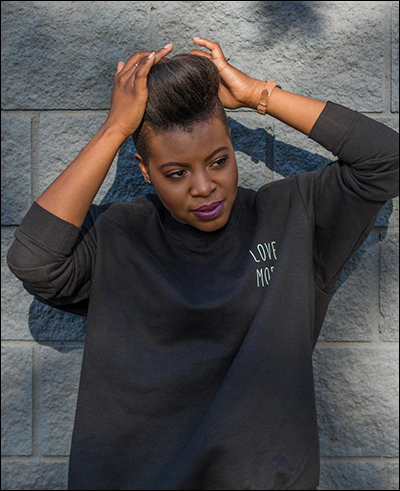
It was through her nifty Web-based tool Conference Calendar that I discovered Kim Goulbourne, aka Bourn: Designer, self-taught Web Developer and proudly self-proclaimed Chronic Creator. You’ll learn why in this interview, where she shares her perspective on pursuing ideas and getting them real.
Appreciating this portrait of your Mom. What experiences/principles from her do you carry with you as sources of contemplation and ambition in your work?
I’ve actually just come to realize how similar we are. Her entrepreneurial spirit, ambition and independence has definitely rubbed off on me over the years. She’s not one to wait on anyone to get things done and that’s one quality that has been integral to my success as a chronic creator. She’s always pushing herself to think outside the box of what she can achieve and lately has been pushing my siblings and I to do the same.
How did you become a Girl Who Codes? What were some essential steps you took to make this a reality?
I sort of fell into it actually. In college, I studied Graphic Design, and the summer after my sophomore year, my mother wanted to build a website. I told her I’d design it, and for some odd reason, I also wanted to take on the challenge of building it. That summer, I picked up my first book on HTML and CSS—and the rest is history. From there, I took one or two relevant classes at my school, watched tons of videos on Lynda.com and practiced on projects I made up or portfolio sites my friends needed.
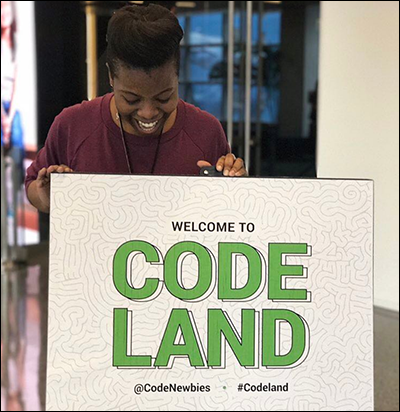
Codeland is a conference for anyone learning how to code. All levels are welcome.
In awe of your formidable portfolio of creative projects: No Questions Asked, More by Bourn, Election Rewind, Bitter Renter NYC, Founder Mantras, Send Thanks and Hshtags. How do you come up with an idea for a creative project? Can you describe this journey from notion to idea to build to launch to post-launch? What was this journey for your newest effort, You & Sundry, for example?
Most of my ideas come from experiences that I’ve had throughout my life. One could say: I’m designing the world I want to see.
When I first have an idea, I write it down in my iOS Notes app. It could be anywhere from one sentence that describes it to multiple notes exploring the full solution. Then it typically sits there for a few weeks, months and even a year (as in the case of You & Sundry). I give my brain time to subconsciously think about why I want to do it and how feasible it would be to do it right now. The ideas that actually make it to launch were the ones I couldn’t stop thinking about for a variety of reasons. There were also the ones that made it past the main two questions I try to always ask my self: “Why do I want to do this project?” and “What is my goal post-launch (i.e. do I plan to iterate)?”
Once I’ve decided to do a project, I pick a start and end/launch date—deadlines are crucial for me to actually complete anything, then I go through the motions of making it a reality.
Post-launch varies from project to project, but it typically involves a little marketing, sharing and basking in the feeling that I made it happen.
You & Sundry started off the same way. I’ve always felt uncomfortable in barbershops, and one night, I laughed to myself as I wrote down the idea for opening a barbershop for women and the LGBTQ community. I thought I was crazy since I knew nothing about the industry or brick-and-mortar businesses. However, one year later after my barber moved, the idea resurfaced, and I decided to give it some real thought in feasibility. I’m still going through the motions right now, but I can definitely say this one will be my biggest venture to date, if I can pull it off.
How do you manage this massive portfolio to ensure each creative project running and humming as well as possible?
The trick here is: I don’t. Apart from paying all the hosting bills, answering the little support emails that come in and checking on each project every once in a while, I don’t actively keep tabs on all the projects I’ve done. This is because my post-launch goal typically includes this fine print: that I won’t iterate. Generally because I probably won’t have the time or interest to keep working on it and adding to it (I learned a lot about myself on my first big project, Hshtags). Therefore, I’ve managed to build my projects in a way where it doesn’t require much upkeep. It solves the immediate problem I wanted to fix and that’s it.
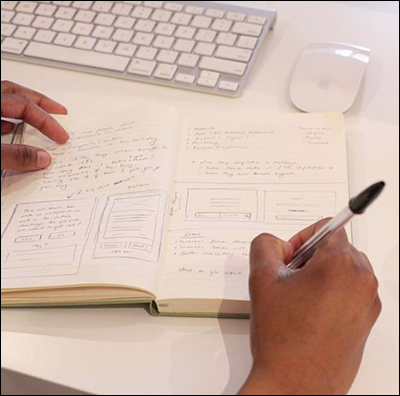
How every project starts—with pen and paper.
Who/what influenced/inspired you to pursue your creative projects full-time and make yourself the client? Or as Seth Godin put it: “Pick yourself.”
I’ve always wanted to be self-employed and I’ve always enjoyed the process of working on my own ideas than a clients.’ But it took time to get here. An opportunity presented itself for me to finally give this crazy business idea a chance—so I took it. It also helped that I saved up enough in time to make this jump.
How would you describe success?
Right now, success for me would mean building a business where I don’t need to rely on client work to sustain the business or my personal life.
With all of the moving parts inherent in making your venture studio—Bourn—how do you deal with busyness and stress? What ways of taking care of yourself have proved beneficial?
Until my shoulder injury, kickboxing was my go-to activity for managing stress. Working out in general also does the trick in keeping my body and mind sharp. I also sleep a lot. Probably too much in fact, but I’m always at my best after a good night’s rest. And now that my “9–5” is my own business, I try to give myself a break ever so often, on nights and weekend to go out, relax with friends and reset.
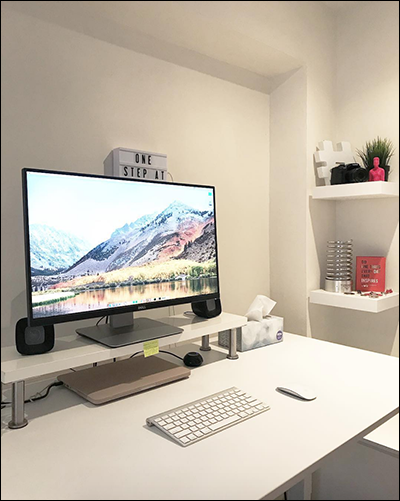
Gave my workspace a makeover—complete with standing desk.
What software/Web-based tools that you use and highly recommend to work on ideas and make them grow, to collaborate and get things done?
My go-to tools are Trello (for organizing features, deadlines and the project overall), Evernote (for notes, to-do lists and ideating) and Google Spreadsheets (for lists that makes more sense in the form of a spreadsheet). I use all of them in some capacity to manage all the moving parts of my projects.
Sketch synced with Dropbox and InVision are my design tools. Sublime Text, iTerm and FileZilla are my dev tools. I use MailChimp for email marketing and Google Analytics.
How would you describe “good design”?
I think good design does a few things for a user. It entices. It’s easy to navigate. It’s effortless to take action without much confusion.
When/if you are approached by someone who expressed, “I want to have a career composed of my creative projects,” what’s your response?
My first reaction would be to dig deeper into their portfolio of “creative projects” to understand what angle they would be considering. After much back and forth to understand their goals, my general response would be: Go for it!
However, if I had to share one thing I learned (and still learning) about this process it would be that as much as you won’t want to think about money (and how you’re going to sustain yourself), it’s going to be the most crucial part of making this dream a reality. I find that as an artist or creative person, the business side of things don’t come as easily, so things like revenue fall through the cracks, but it’s vital to our success.
In these charged times, what can individuals in the design and web development worlds, whatever the discipline, do to contribute immediately to a better community/society/world moving forward?
I think using our skill sets to help, share, educate and inspire, in whatever ways we can or are comfortable with, will always be helpful. But in my opinion, it has to come from the right place or it won’t be as effective.
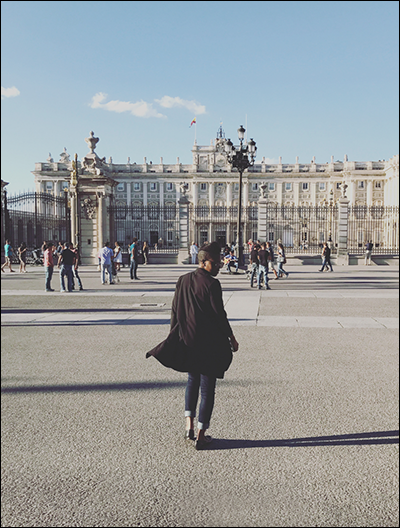
Madrid, Spain.
From your traveling locally/internationally, is there a destination you find yourself wanting to experience again and again?
I’m definitely a little obsessed with California but haven’t made the jump to move there yet. After my travel overseas however, I would love to experience much more of Europe and broaden my travels to South America, Africa, Asia, Australia, the Caribbean, basically as many places as I can while I still can.
How does the city of New York contribute to your work? What makes it special for startups/business/creativity-at-large?
New York is such a fast-paced city filled with go-getters. Because I identify with that culture and feeling, I think that’s why I’ve lasted so long here. I feel inspired to push myself when I see others pushing themselves from afar. I’ve walked into so many coffee shops and have appreciated seeing other people who are also on their grind.
I think it’s special for startups/business/creativity-at-large because of the community that exists here across the board. Almost every industry has a thriving community, from tech to fashion to the arts. With that community comes inspiration, collaboration and innovation.
What total effect do you strive to achieve through your work?
On a deeper level, I silently hope to touch someone in some capacity. It could be as simple as them gaining knowledge in an area that was confusing before (Bitter Renter), giving them easier ways to explore more of their city (No Questions Asked) or providing a space where they feel comfortable being themselves (You & Sundry). Even though all my projects start with me in mind, I secretly hope I’m not the only one who will benefit from it.
• • •
All images courtesy of Kim Goulbourne.
• • •
Read more from Design Feast Series of 370+ Interviews with people who love making things.
❤️ Donating = Appreciating: Help keep Design Feast going!
Lots of hours are put into making Design Feast—because it’s a labor of love to provide creative culture for everyone through hundreds of interviews, including event write-ups. Please consider becoming a supporting Patron with a recurring monthly donation.
Visit my Patreon page where you can view my goals and reward tiers—starting at $1 per month. Starting your patronage today matters—it’ll help Design Feast remain available, even grow.

